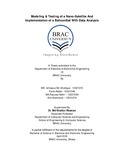Modeling and testing of a nano-satellite and implementation of a BalloonSat with data analysis
Abstract
Satellites are very expensive for developing countries like Bangladesh to facilitate, for which these countries can approach Nano-satellite or balloon satellite which are cheaper compared to a satellite. A Nano-satellite should be designed in such a manner that it can withstand the harsh environments of space and meet all the criteria of carrier vehicle companies. On the other hand, a balloon satellite is much cheaper, easier to construct and is an excellent illustration of a Nano-satellite although it could not perform all the possible functions of it. This paper demonstrates a remodeled version of a Nano-satellite model proposed by an earlier group from BRAC University and also the structural feasibility of that remodeled structure by performing a vibration analysis on it. Additionally, it also implements a balloon satellite circuit for monitoring crop health and deforestation activities by sending images over which are later processed on the ground station. The circuit also sends latitude, longitude, temperature, pressure, light intensity, pitch, roll, heading, UV index, infrared, CPU temperature data using sensors and modules, the balloon satellite is tracked using the latitude and longitude readings. The data transmission occurs wirelessly and is maintained by a Raspberry Pi B+ which runs by itself on boot. These data are received on a ground platform where they are displayed in a GUI in a proper manner and are being saved as well.

